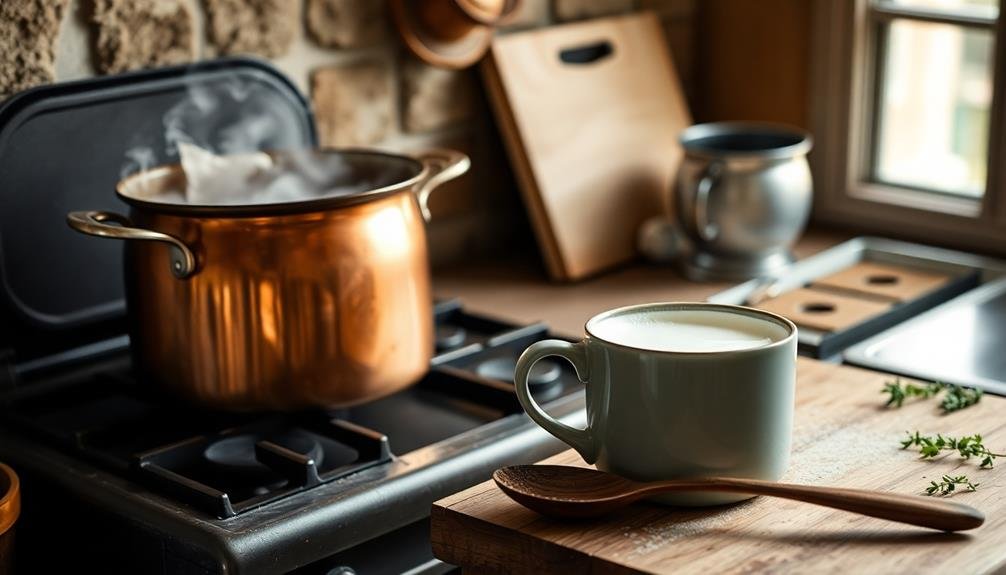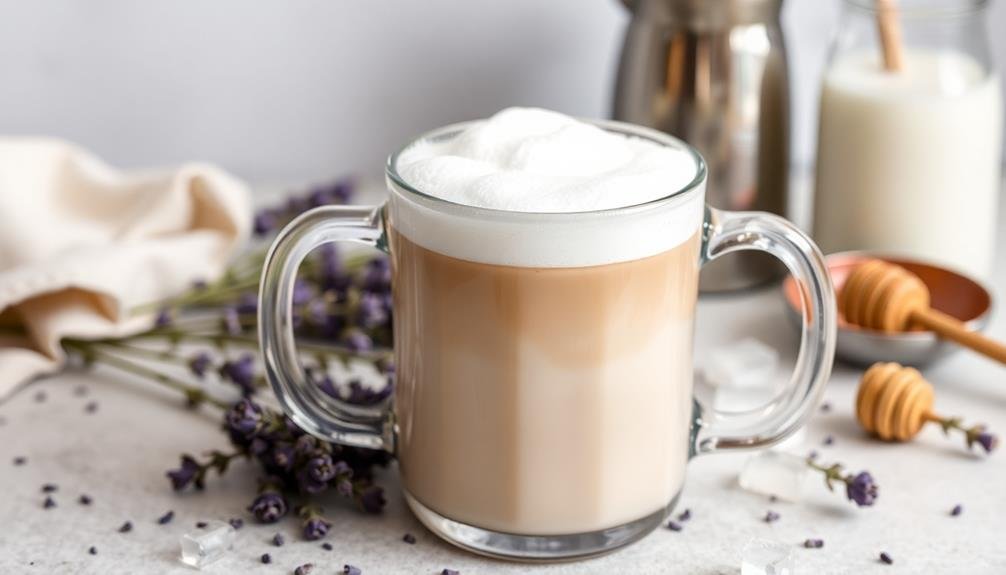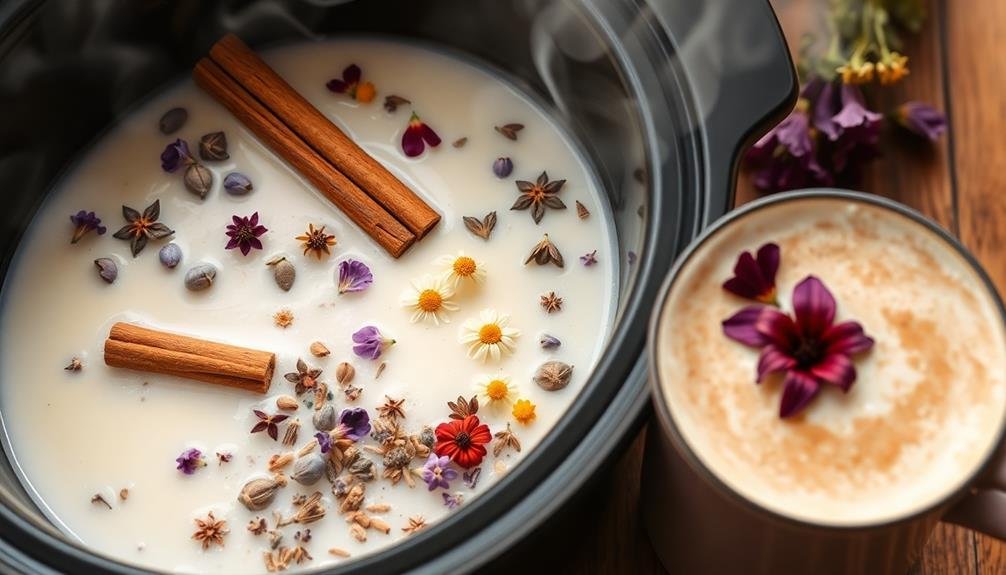You can easily craft delicious herbal tea lattes at home using five simple techniques. Try the classic stovetop method for a traditional approach, or use a milk frother for quick and creamy results. For a revitalizing twist, make an iced herbal latte perfect for warm days. Channel your inner barista with a matcha-inspired whisking technique, creating a smooth and frothy beverage. If you're preparing for a crowd or want a hands-off method, the slow cooker infusion is ideal. Each technique offers unique benefits and flavors, allowing you to customize your herbal tea latte experience. Dive deeper to reveal the secrets of these versatile methods.
The Classic Stovetop Method

Tea lovers, rejoice! The classic stovetop method for crafting herbal tea lattes is a timeless technique that'll elevate your tea-drinking experience.
To begin, choose your favorite loose-leaf herbal tea blend. You'll need about 1-2 teaspoons per cup of water. Heat water in a small saucepan until it's just below boiling. Add your tea leaves and let them steep for 3-5 minutes, depending on the blend.
While the tea steeps, warm your milk of choice in a separate pan. For a creamy latte, use whole milk or a rich plant-based alternative like oat or coconut milk. Once the milk is hot, use a whisk or handheld frother to create a velvety foam.
Strain your brewed tea into a mug, then gently pour the frothed milk over it. For an extra touch, sprinkle some dried herbs or a dash of cinnamon on top.
This method allows you to control the strength of your tea and the richness of your milk, resulting in a perfectly balanced herbal tea latte tailored to your taste preferences.
Blending With a Milk Frother
For those seeking a quicker method, blending with a milk frother offers a convenient alternative. This technique allows you to create frothy, café-style lattes in minutes without the need for a stovetop or steamer.
To begin, brew a strong cup of your favorite herbal tea. While it's steeping, warm your milk of choice in the microwave or on the stovetop.
Once the tea is ready, pour it into your serving mug. Next, use your milk frother to blend the warmed milk until it's light and airy. This usually takes about 30-60 seconds, depending on your frother's power.
Gently pour the frothed milk over your herbal tea, holding back the foam with a spoon. Once you've added the desired amount of milk, spoon the remaining foam on top. For an extra touch, you can dust the foam with a sprinkle of cinnamon, cocoa powder, or dried herb flakes.
This method works well with both electric and manual frothers. If you don't have a frother, you can achieve similar results using a blender or even a jar with a tight-fitting lid to shake the milk vigorously.
Iced Herbal Latte Technique

When summer heat calls for a revitalizing twist on herbal lattes, the iced version offers a cool and stimulating alternative.
To craft the perfect iced herbal latte, start by brewing a strong concentrate of your favorite herbal tea. Use twice the amount of tea leaves you'd normally use and steep for 5-7 minutes in hot water.
While the tea steeps, fill a tall glass with ice cubes.
Once your tea concentrate is ready, strain it directly over the ice. Next, prepare your milk of choice. For a creamy texture, use a milk frother to create cold foam. If you don't have a frother, shake the milk vigorously in a sealed jar for 30 seconds.
Slowly pour the frothed milk over the iced tea, allowing it to create distinct layers.
For added sweetness, stir in a touch of honey or your preferred sweetener before adding the milk. Experiment with different herb combinations like lavender-chamomile or mint-lemongrass for unique flavors.
Don't forget to garnish with fresh herbs or a sprinkle of cinnamon for an extra aromatic touch. Serve immediately and enjoy your invigorating iced herbal latte.
Matcha-Inspired Whisking Approach
Moving from cold to hot preparations, let's explore a technique borrowed from traditional matcha ceremonies. The matcha-inspired whisking approach can elevate your herbal tea lattes to new heights of frothy perfection.
Start by sifting 1-2 teaspoons of finely ground herbal tea powder into a wide, shallow bowl. Add a small amount of hot water, just enough to create a paste. Using a bamboo whisk or a small wire whisk, vigorously whisk the mixture in a "W" or "M" pattern. This rapid motion incorporates air, creating a smooth, frothy consistency.
Once you've achieved a uniform paste, slowly add more hot water while continuing to whisk. The key is to maintain a brisk whisking motion to keep the froth intact. As you add water, you'll notice the mixture becoming lighter and more bubbly.
For a latte, transfer this whisked tea to a mug and top with steamed milk of your choice. The matcha-inspired technique works particularly well with finely ground herbs like peppermint, chamomile, or rooibos.
You'll enjoy a silky smooth latte with a delightful layer of foam on top.
Slow Cooker Infusion Method

A multitude of herbal tea enthusiasts are discovering the magic of the slow cooker infusion method. This technique allows you to create rich, flavorful herbal tea lattes with minimal effort.
To begin, add your chosen herbs or tea leaves to the slow cooker along with water. Set the cooker to low heat and let it infuse for 2-4 hours, depending on the desired strength.
Once the infusion is complete, strain the liquid and return it to the slow cooker. Add your preferred milk or milk alternative, and let it warm for another 30 minutes. This step guarantees a creamy, well-blended latte. You can also add sweeteners or spices at this point to enhance the flavor profile.
The slow cooker method is ideal for large batches, making it perfect for gatherings or meal prep. It's also a great way to experiment with different herb combinations and steep times.
Remember to adjust the liquid ratios based on your taste preferences. For a stronger brew, use more herbs or a longer infusion time. For a milder flavor, reduce the amount of herbs or shorten the steeping duration.
Frequently Asked Questions
Can I Use Non-Dairy Milk Alternatives for Herbal Tea Lattes?
Yes, you can definitely use non-dairy milk alternatives for herbal tea lattes. You'll find that options like almond, soy, oat, or coconut milk work well. They'll give your latte a unique flavor and cater to dietary preferences or restrictions.
How Long Can I Store Homemade Herbal Tea Latte Mixtures?
You can store homemade herbal tea latte mixtures in the refrigerator for up to 3-5 days. Make sure to keep them in an airtight container. It's best to consume them fresh, as flavors may deteriorate over time.
Are There Any Herbal Teas to Avoid When Making Lattes?
You should avoid using certain herbal teas in lattes. Steer clear of teas with strong medicinal properties, like St. John's Wort or valerian root. Also, skip teas that don't blend well with milk, such as chamomile or lemongrass.
What Sweeteners Work Best for Herbal Tea Lattes?
You'll find honey, agave, or maple syrup work wonders for herbal tea lattes. They're natural and complement the flavors well. If you prefer low-calorie options, try stevia or monk fruit sweetener. Don't forget, some herbs are naturally sweet.
Can I Use Pre-Made Herbal Tea Bags for These Latte Recipes?
Yes, you can use pre-made herbal tea bags for latte recipes. They're convenient and offer a variety of flavors. However, you'll get the best results by steeping them longer and using more bags than you normally would.
In Summary
You've now mastered five versatile techniques for crafting delicious herbal tea lattes. Whether you prefer the classic stovetop method or want to experiment with iced versions, there's an approach for every taste and season. Don't be afraid to mix and match these methods or invent your own variations. With practice, you'll soon be creating cafe-quality lattes in your own kitchen. So go ahead, brew up a comforting mug, and savor your homemade herbal creations.





Leave a Reply